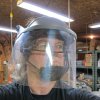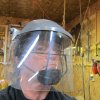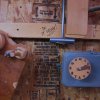Some of the sports gear converted for safety use might be an exception but I have noticed that with face shields, face shield/helmet combo's, anything with adjustable suspension systems, the adjustable system seems to always fail in an accident severe enough to result in injuries. Often it fails in accidents that don't cause injuries of any significance.
My own experience was with an industrial hard hat with the adjustable plastic system. A twenty feet long piece of roughly two and a half inch pipe was used as a brace or bracket and not secured properly at the top end. It was vertical and the free end had quite a running start when it hit me on the side of the head as I was standing near it working. Couldn't see it coming and it hit the side of my hard hat and knocked me flying. The hat had a four inch or longer crease in it and every adjustment torn loose as well as some of the mounting points. I had a headache and a stiff neck, not much to complain about considering what I would have had without the hat on.
There is no doubt that the failure of the suspension serves somewhat as a crumple or crush zone absorbing some of the energy of the impact but it also seems that it is often the weakest point in some of our gear. Any modification would of course make any injury while using the gear our own responsibility but if a small piece of string or two or a plastic cable wrap or two beefed up the protection of my helmet I think I would risk the liability issue. I don't think there is a legal issue to consider anyway because the helmets are rated far lower than to offer protection in the types of injuries turners are getting badly injured in. When the safety gear fails in the accidents I am reading about we were obviously outside it's stated and rated design perimeters so we had no legal expectation of protection.
Brings me to the final thought in this post. The AAW has taken a major interest in safety and is doing what they feel they can. I agree they can't control what we do in our own shops although we may eventually face insurance considerations that can indeed dictate what we can do in our own shop, been there before! One thing I think the AAW may be able to do is consult with some of the safety gear manufacturers and use the clout of numbers to try to get headgear designed specifically for wood turners. Once made, others would certainly find it useful too but I think a higher level of protection than I have with a very popular face shield could be had for very little additional expense. I plan to go to a filtered air system soon but they don't have an impressive safety rating either.
Thoughts? Could the AAW produce numbers of members, an estimate of total wood turners, and money spent by wood turners to try to persuade a manufacturer to make gear that would suit us best or at least much better? At risk of having to buy more than one suspension system, I would like a system that was one time adjustable then fixed permanently in place, maybe just a few plastic push thingies that look like a rivet. Those could be cut out and moved if necessary but would still offer far more strength than current designs alone. Slightly beefed up main assembly to keep weight moderate and at least meet latest standards or a standard we request, beefier suspension so it doesn't fail prematurely as seems the case now, at least in my limited observations. Nothing in the world that is practical to wear is going to protect us in some of the accidents but it does seem we could be doing better at mitigating injuries.
Hu
My own experience was with an industrial hard hat with the adjustable plastic system. A twenty feet long piece of roughly two and a half inch pipe was used as a brace or bracket and not secured properly at the top end. It was vertical and the free end had quite a running start when it hit me on the side of the head as I was standing near it working. Couldn't see it coming and it hit the side of my hard hat and knocked me flying. The hat had a four inch or longer crease in it and every adjustment torn loose as well as some of the mounting points. I had a headache and a stiff neck, not much to complain about considering what I would have had without the hat on.
There is no doubt that the failure of the suspension serves somewhat as a crumple or crush zone absorbing some of the energy of the impact but it also seems that it is often the weakest point in some of our gear. Any modification would of course make any injury while using the gear our own responsibility but if a small piece of string or two or a plastic cable wrap or two beefed up the protection of my helmet I think I would risk the liability issue. I don't think there is a legal issue to consider anyway because the helmets are rated far lower than to offer protection in the types of injuries turners are getting badly injured in. When the safety gear fails in the accidents I am reading about we were obviously outside it's stated and rated design perimeters so we had no legal expectation of protection.
Brings me to the final thought in this post. The AAW has taken a major interest in safety and is doing what they feel they can. I agree they can't control what we do in our own shops although we may eventually face insurance considerations that can indeed dictate what we can do in our own shop, been there before! One thing I think the AAW may be able to do is consult with some of the safety gear manufacturers and use the clout of numbers to try to get headgear designed specifically for wood turners. Once made, others would certainly find it useful too but I think a higher level of protection than I have with a very popular face shield could be had for very little additional expense. I plan to go to a filtered air system soon but they don't have an impressive safety rating either.
Thoughts? Could the AAW produce numbers of members, an estimate of total wood turners, and money spent by wood turners to try to persuade a manufacturer to make gear that would suit us best or at least much better? At risk of having to buy more than one suspension system, I would like a system that was one time adjustable then fixed permanently in place, maybe just a few plastic push thingies that look like a rivet. Those could be cut out and moved if necessary but would still offer far more strength than current designs alone. Slightly beefed up main assembly to keep weight moderate and at least meet latest standards or a standard we request, beefier suspension so it doesn't fail prematurely as seems the case now, at least in my limited observations. Nothing in the world that is practical to wear is going to protect us in some of the accidents but it does seem we could be doing better at mitigating injuries.
Hu








